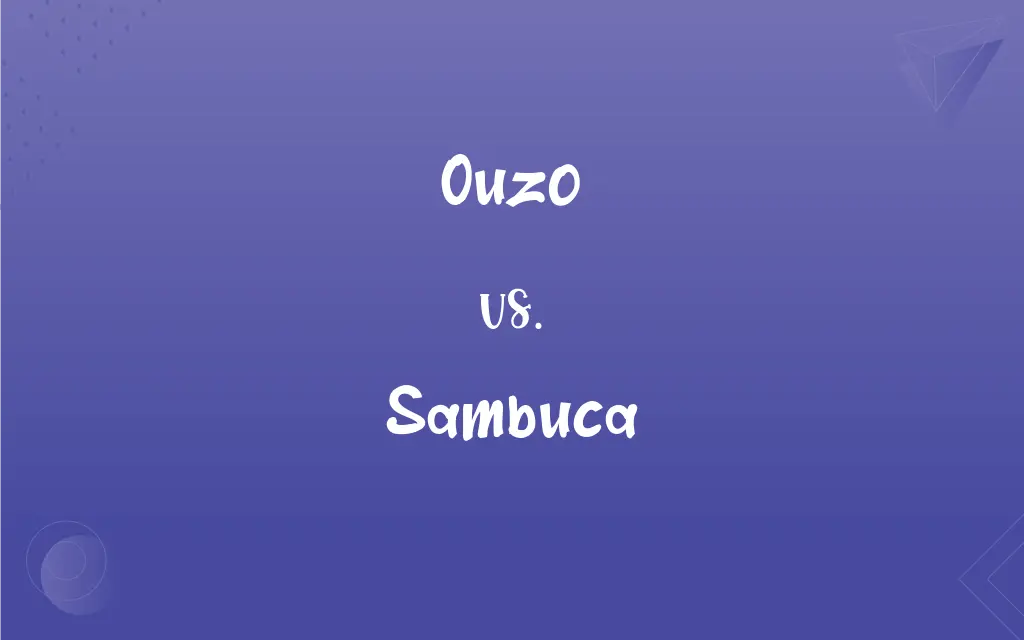Ouzo vs. Sambuca: What's the Difference?
Edited by Aimie Carlson || By Janet White || Published on February 13, 2024
Ouzo is a Greek anise-flavored liqueur, often enjoyed with water, while Sambuca is an Italian anise-flavored liqueur, commonly served with coffee beans.

Key Differences
Ouzo, a traditional Greek liqueur, is known for its strong anise flavor and is often mixed with water, turning milky white. In contrast, Sambuca, originating from Italy, also has a distinct anise flavor but is typically consumed neat or with coffee beans ('con la mosca').
The alcohol content in ouzo varies but generally hovers around 40%. Sambuca, on the other hand, is slightly stronger, with alcohol content often exceeding 40%.
Ouzo is made by distilling grape must and then flavoring it with anise and other botanicals. Sambuca's production involves infusing alcohol with anise, licorice, and other spices, offering a slightly sweeter taste.
In Greece, ouzo is a staple in social gatherings and is often accompanied by small appetizers called meze. Sambuca in Italy is commonly served as a digestif after meals and is sometimes flamed in the glass to enhance its flavor.
The cultural significance of ouzo lies in its representation of Greek hospitality and cuisine. Conversely, Sambuca is emblematic of Italian conviviality, often enjoyed in a relaxed social setting.
ADVERTISEMENT
Comparison Chart
Origin
Greek
Italian
Flavor
Strong anise
Anise, slightly sweeter
Common Way to Serve
With water, turns milky
Neat or with coffee beans
Alcohol Content
Around 40%
Often above 40%
Cultural Context
Social gatherings, with meze
Digestif, post-meal, sometimes flamed
ADVERTISEMENT
Ouzo and Sambuca Definitions
Ouzo
A Greek anise-flavored liqueur.
We enjoyed a glass of ouzo by the seaside taverna in Greece.
Sambuca
A symbol of Italian conviviality and post-meal tradition.
Sambuca, enjoyed in a relaxed setting, reflected true Italian hospitality.
Ouzo
A traditional Greek drink served with meze.
Ouzo, accompanied by a variety of meze, made for a perfect appetizer.
Sambuca
A sweet, anise-based spirit from Italy.
The sambuca's sweetness complemented the strong anise flavor beautifully.
Ouzo
A distilled spirit from Greece, often mixed with water.
When water was added to the ouzo, it turned a milky white color.
Sambuca
A digestif often served with coffee beans.
The sambuca was presented 'con la mosca', with three coffee beans.
Ouzo
A liqueur representing Greek hospitality.
Ouzo was offered as a sign of warm Greek hospitality at the dinner.
Sambuca
An Italian anise-flavored liqueur.
After dinner, we savored a shot of smooth sambuca.
Ouzo
An alcoholic beverage integral to Greek culture.
Ouzo is more than just a drink; it's a part of Greek cultural identity.
Sambuca
An alcoholic beverage known for its versatility in cocktails.
The bartender used sambuca to add a unique twist to the cocktail.
Ouzo
A colorless, unsweetened Greek liqueur flavored with anise.
Sambuca
An ancient triangular stringed instrument.
Ouzo
(uncountable) An anise-flavoured aperitif, originating in Greece.
Sambuca
An Italian liqueur with the flavor of anise.
Ouzo
(countable) A serving of this drink.
Sambuca
An Italian liqueur made from elderberries and flavoured with licorice, traditionally served with 3 coffee beans that represent health, wealth and fortune (or past, present and future).
Ouzo
Anise-flavored Greek liquor
Sambuca
(musical instruments) An ancient form of triangular harp having a very sharp, shrill tone.
Sambuca
An ancient type of ship-borne siege engine.
Sambuca
An Italian liqueur made with elderberries and flavored with licorice
FAQs
How is sambuca different from ouzo?
Sambuca is an Italian anise-flavored liqueur, usually sweeter and served with coffee beans.
What's the alcohol content in ouzo?
The alcohol content in ouzo is typically around 40%.
How strong is sambuca compared to ouzo?
Sambuca often has an alcohol content above 40%, slightly stronger than ouzo.
How is ouzo traditionally consumed?
Ouzo is often mixed with water, which turns it milky white.
What is ouzo?
Ouzo is a Greek anise-flavored liqueur traditionally served with water.
What is the traditional way to serve sambuca?
Sambuca is traditionally served neat or with coffee beans.
What food pairs well with ouzo?
Ouzo pairs well with Greek appetizers like olives, cheese, and seafood.
Is sambuca used in cooking?
Sambuca can be used in cooking, particularly in desserts and sauces.
Can you mix ouzo in cocktails?
Yes, ouzo can be mixed in cocktails, adding a unique anise flavor.
Does ouzo have any variations?
Ouzo can vary in flavor and potency depending on the distillery and region.
Can sambuca be served with ice?
Sambuca can be served over ice, but it's traditionally served neat.
What is the louche effect in ouzo?
The louche effect is the milky appearance ouzo gets when mixed with water.
Is sambuca a digestif?
Yes, sambuca is commonly consumed as a digestif in Italy.
What's the history of ouzo?
Ouzo has a rich history in Greece, linked to its tradition of distilling spirits.
How is sambuca traditionally made?
Sambuca is made by infusing alcohol with anise, licorice, and other spices.
Can non-Greeks enjoy ouzo?
Absolutely, ouzo is enjoyed worldwide for its unique flavor.
Can sambuca be flamed?
Yes, flaming sambuca is a popular way to enhance its flavor, often done in bars.
Is ouzo similar to Turkish raki?
Ouzo is similar to Turkish raki in flavor, but they are distinct spirits.
Are there different types of sambuca?
Yes, sambuca comes in various flavors, including black (licorice) and red (spicy).
Is sambuca popular outside of Italy?
Yes, sambuca has gained international popularity, especially in bars and restaurants.
About Author
Written by
Janet WhiteJanet White has been an esteemed writer and blogger for Difference Wiki. Holding a Master's degree in Science and Medical Journalism from the prestigious Boston University, she has consistently demonstrated her expertise and passion for her field. When she's not immersed in her work, Janet relishes her time exercising, delving into a good book, and cherishing moments with friends and family.
Edited by
Aimie CarlsonAimie Carlson, holding a master's degree in English literature, is a fervent English language enthusiast. She lends her writing talents to Difference Wiki, a prominent website that specializes in comparisons, offering readers insightful analyses that both captivate and inform.







































































